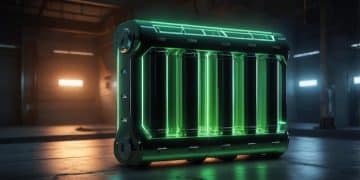Emerging Energy Storage Technologies: US Market Domination by 2030

By 2030, the US energy storage market will likely be dominated by advanced lithium-ion batteries, flow batteries, solid-state batteries, and thermal energy storage, driven by increasing demand for grid stabilization, electric vehicle adoption, and renewable energy integration.
The landscape of energy storage is rapidly evolving, and understanding **what emerging energy storage technologies will dominate the US market by 2030** is crucial for investors, policymakers, and consumers alike. This article explores the most promising technologies poised to reshape the way energy is stored and utilized in the coming years.
The Current State of Energy Storage in the US
The energy storage sector in the United States is experiencing unprecedented growth, fueled by the increasing adoption of renewable energy sources and the need for a more resilient and reliable grid. Understanding the current scenario sets the stage for analyzing which technologies will lead the market by 2030.
Growth Drivers in the US Energy Storage Market
Several factors are contributing to the rapid expansion of the energy storage market. These include declining battery costs, supportive government policies, and increasing demand for grid-scale storage solutions.
- Federal and state incentives, such as tax credits and grants, are making energy storage projects more economically viable.
- The rising penetration of solar and wind energy necessitates energy storage to address intermittency issues.
- Rapid advancements in battery technology are leading to higher energy densities and longer lifecycles.
Dominant Technologies Today
Currently, lithium-ion batteries are the most widely deployed energy storage technology in the US. However, other technologies are gaining traction, driven by specific applications and technological advantages.
While lithium-ion batteries lead in grid-scale and residential storage, pumped hydro storage still holds a significant share due to its high capacity and long duration capabilities. Emerging technologies like flow batteries and solid-state batteries are starting to make inroads, promising enhanced performance and safety.

In conclusion, the current energy storage market in the US is dominated by lithium-ion batteries, but diversification is on the horizon. Support from energy-efficient government policies and technological advancements will be crucial for emerging technologies to reach their potential.
Lithium-Ion Batteries: An Evolving Landscape
Lithium-ion batteries have become synonymous with energy storage due to their widespread use in electric vehicles and consumer electronics. Their continued evolution and adaptation will be vital in holding a spot among the technologies that stand out in the US market by 2030.
Advancements in Lithium-Ion Technology
Ongoing research and development efforts are focused on improving the energy density, safety, and lifespan of lithium-ion batteries. These advancements are essential for meeting the demands of various applications, from electric vehicles to grid-scale storage.
- The development of nickel-manganese-cobalt (NMC) and nickel-cobalt-aluminum (NCA) chemistries is increasing energy density and reducing costs.
- Solid-state electrolytes are being explored to enhance safety and enable higher energy densities.
- Advanced manufacturing techniques are helping to reduce production costs and improve battery performance.
Applications and Market Segments
Lithium-ion batteries are versatile and can be used in a variety of applications, including electric vehicles, grid-scale storage, residential storage, and portable power.
The electric vehicle market is driving significant demand for lithium-ion batteries, with automakers investing heavily in battery technology. Grid-scale storage projects are also growing, as utilities seek to integrate more renewable energy into the grid. Residential storage systems, paired with solar panels, are becoming increasingly popular among homeowners.

To conclude, lithium-ion batteries are expected to remain a dominant force in the energy storage market, but their continued success will depend on ongoing advancements in technology and manufacturing. They must evolve to provide safer and more efficient energy storage to accommodate markets like electric cars and portable power.
Flow Batteries: Scalable and Long-Duration Storage
Flow batteries offer unique advantages for long-duration energy storage, making them well-suited for grid-scale applications. Their scalability and operational life can pose a competitive edge in the US market by 2030.
How Flow Batteries Work
Flow batteries store energy in liquid electrolytes, which are pumped through a stack of electrochemical cells. This design allows for independent scaling of power (stack size) and energy capacity (electrolyte volume).
Unlike traditional batteries, flow batteries do not degrade with cycling, resulting in a long lifespan of 20 years or more. They also offer high round-trip efficiency and can operate at a wide range of temperatures.
Advantages and Limitations
Flow batteries offer several key advantages over other energy storage technologies, including scalability, long lifespan, and high safety. However, they also have some limitations, such as lower energy density and higher upfront costs.
- Flow batteries are ideal for applications requiring long-duration storage, such as grid stabilization and renewable energy integration.
- Their modular design allows for easy expansion of storage capacity to meet growing demand.
- The use of non-flammable electrolytes enhances safety and reduces fire risk.
In essence, flow batteries represent a promising solution for long-duration energy storage, offering scalability and durability. Overcoming the limitations of cost and energy density would greatly improve their position as market leaders by 2030.
Solid-State Batteries: The Next Generation
Solid-state batteries are emerging as a promising next-generation energy storage technology, offering significant improvements in energy density, safety, and performance. Their potential impact on the US market by 2030 is substantial.
The Promise of Solid-State Electrolytes
Solid-state batteries replace the liquid electrolyte found in conventional lithium-ion batteries with a solid electrolyte. This eliminates the risk of leaks and thermal runaway, resulting in safer and more stable batteries.
Solid-state electrolytes also enable the use of high-energy-density electrode materials, such as lithium metal. This can significantly increase the energy density of batteries, allowing for longer driving ranges in electric vehicles and extended operating times for portable devices.
Challenges and Development Status
Despite their potential, solid-state batteries face several challenges, including high manufacturing costs and limited cycle life. However, ongoing research and development efforts are focused on addressing these challenges.
Automakers and battery manufacturers are investing heavily in solid-state battery technology, with the goal of bringing commercially viable solid-state batteries to market in the next few years. Several companies have already demonstrated promising prototypes, and pilot production lines are being established.
Overall, solid-state batteries are well-positioned to become a game-changing technology in the energy storage sector. Though they face some manufacturing difficulties and high costs, solid-state batteries have the potential to make a big impact on the market by 2030.
Thermal Energy Storage: A Sustainable Solution
Thermal energy storage (TES) is a sustainable solution for storing energy in the form of heat or cold. It offers several advantages, including high efficiency, low cost, and environmental friendliness. Its role in the US market by 2030 is expected to grow substantially.
Types of Thermal Energy Storage
There are several types of TES technologies, including sensible heat storage, latent heat storage, and thermochemical storage. Each type has its own advantages and limitations, depending on the application and storage requirements.
Sensible heat storage involves storing energy by raising the temperature of a storage medium, such as water, rock, or sand. Latent heat storage uses phase change materials (PCMs) to store energy during melting or freezing. Thermochemical storage involves reversible chemical reactions to store and release energy.
Applications and Benefits
TES can be used in a variety of applications, including district heating and cooling, industrial process heating, and building energy management.
- TES systems can store excess heat generated during off-peak hours and release it during peak hours, reducing energy costs and improving grid stability.
- TES can also be used to store solar thermal energy for later use, enabling continuous operation of solar power plants.
- PCM-based TES systems can improve the energy efficiency of buildings by storing heat during the day and releasing it at night.
In conclusion, thermal energy storage is a sustainable and cost-effective solution for storing energy. TES can be applied in building energy management, district heating, and more to improve energy efficiency.
The Role of Policy and Investment
Government policies and private investments play a crucial role in shaping the future of energy storage. Supportive policies can accelerate the deployment of emerging technologies, while strategic investments can drive innovation and reduce costs. By analyzing the role of policies and investments, one can better understand what technologies may succeed by 2030.
Government Incentives and Regulations
Federal and state governments are implementing a range of policies to promote energy storage, including tax credits, grants, and mandates. These policies aim to reduce the cost of energy storage projects, encourage innovation, and ensure grid reliability.
The Investment Tax Credit (ITC) provides a tax credit for energy storage projects, making them more economically attractive. State-level mandates require utilities to procure a certain amount of energy storage capacity, creating a guaranteed market for these technologies.
Private Sector Investments
Private sector investments are also driving the growth of the energy storage market. Venture capital firms, private equity funds, and corporate investors are pouring billions of dollars into energy storage companies, driving innovation and scaling up production.
Automakers are investing heavily in battery technology, as they transition to electric vehicles. Utilities are investing in grid-scale storage projects to improve grid reliability and integrate more renewable energy. Technology companies are developing innovative energy storage solutions, such as solid-state batteries and flow batteries.
To conclude, government policies and private investments are essential drivers of the energy storage economy in the US, and will determine which technologies prevail by 2030.
| Key Point | Brief Description |
|---|---|
| ⚡ Lithium-Ion Dominance | Lithium-ion batteries are currently the most prevalent storage technology. |
| 💧 Flow Battery Scalability | Flow batteries offer scalable and long-duration storage solutions. |
| 🔋 Solid-State Potential | Solid-state batteries promise enhanced energy density and safety. |
| 🔥 Thermal Energy Storage | Thermal energy storage offers sustainable energy solutions. |
FAQ
The key factors driving growth include declining battery costs, supportive government policies, increasing renewable energy adoption, and the need for grid stabilization.
Flow batteries store energy in liquid electrolytes, allowing for independent scaling of power and energy capacity, and they have longer lifespans compared to lithium-ion batteries.
Solid-state batteries offer enhanced energy density and safety by replacing the liquid electrolyte with a solid one, reducing the risk of leaks and thermal runaway.
Thermal energy storage is used in district heating and cooling, industrial process heating, and building energy management to store energy in the form of heat or cold.
Government policies, such as tax credits and mandates, incentivize energy storage projects, encourage innovation, and help ensure grid reliability.
Conclusion
As we look towards 2030, the US energy storage market will be shaped by a diverse array of technologies, each offering unique benefits and addressing different needs. While lithium-ion batteries are the dominant technology today, flow batteries, solid-state batteries, and thermal energy storage solutions are poised to play increasingly important roles. The interplay of technological advancements, government policies, and private investments will ultimately determine which technologies will lead the way in creating a more reliable, sustainable, and resilient energy future for the United States.





